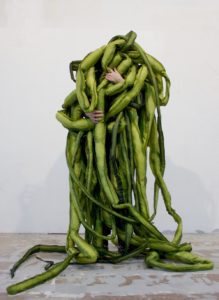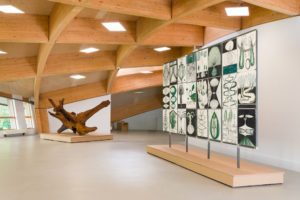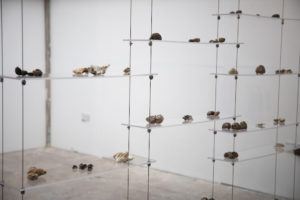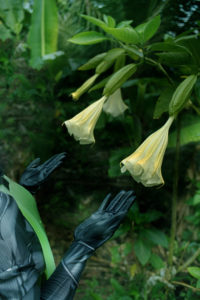A new exhibition exploring interdependencies between humans and plants, featuring works by the likes of Kedisha Coakley, Patricia Domínguez, Iman Datoo, Ingela Ihrman, Eduardo Navarro and Ai Weiwei, is now open at the Eden Project until February 2023.

Ingela Ihrman – ‘A Great Seaweed Day: Gut Weed (Ulva Intestinalis)’, 2019. Textile, silk, glue and dye, dimensions variable
Plants feed, fuel and nurture us, provide the very air we breathe, and colour the fabric of our lives. Super Natural features artists who each explore and reflect on human relationships with plants, as well as on how people perceive nature – and their place within it – in varying ways. The exhibition encourages all of us to consider how different perspectives can inform and influence a shared understanding of nature and to celebrate the power of our imagination to reunite us with the natural world.

Ai Weiwei’s ‘Fly’ (2019) and Eduardo Navarro’s ‘Photosynthetics’ (2021)
Works include Ai Weiwei’s Roots, a series of monumental sculptural works in iron, cast from giant tree roots sourced in Brazil during research and production for the artist’s survey exhibition ‘Raiz’ at OCA Pavilion, São Paulo. Some of the roots that were molded could be over a thousand years old. ‘Fly’ (2019), from the series of works, is on display at Eden. It reflects ancient cultures and man’s first tools for tree felling and woodwork and a tangible ‘uprootedness’ that mirrors the artist’s own life after being allowed to leave China in 2015, alongside the plight of refugees and indigenous populations that Ai has spent years documenting.
Kedisha Coakley’s ‘Horticultural Appropriation’ (2022) is an archive of memories and experiences displayed through botanical and natural objects, such as volcanic rock, salt crystals, passionfruit and lychee. They form an investigation into the idea of repatriating knowledge and untold legacies. Coakley questions what is lost and what remains when botanical objects are removed from their native lands.

Kedisha Coakley – ‘Horticultural Appropriation’
Iman Datoo’s work explores our tacit language, knowledge and narratives with plants and seeks to enrich our vocabulary through mapmaking, sculpture and film. ‘Kinomic Botany’ (2022) is a 10-minute film that visualises a parallel world through ‘eyes’ of a potato, freeing it from its scientific and colonial ties.
Datoo’s ‘Making a Name’ is an interactive and collaborative artwork composed of audio instructions inviting participants to be inspired and derive new names for plants through non-verbal methods of interacting with a potato. Participants’ individual observations will be written and collected as an evolving body of words by the artist. A Yukon Gold potato may be described as ‘yellow-as-the-tired-belly-of-
Patricia Domínguez’s digital and sculptural piece ‘Matrix Vegetal’ (2021/22) brings together experimental research on ethnobotany, healing practices and the commercialisation of wellbeing. ‘Matrix Vegetal’ is a video work presented within a futuristic totem that examines some of these themes, as well as focussing on South American quantum thinking, dream fiction and organic connection technologies.

Patricia Domínguez’s ‘Matrix Vegetal’
Swedish artist Ingela Ihrman has created ‘A Great Seaweed Day’ to investigate links between intestinal and marine flora. The trailing dyed silk of ‘Gut Weed’ (2019) is based on Ulva Intestinalis – a thin, tubular algae, commonly known as ‘mermaid’s necklace’ or ‘gut weed’. The draping red-dyed cotton of ‘Sea Belt’ (2019) represents Dilsea carnosa – a species of red algae. Ihrman was inspired by a quote from the diary of Victorian housewife and marine botanist Margaret Gatty (1809-1873) who had a great passion for seaweed, sparked when retreating to the coast to recover from the latest of seven strenuous pregnancies. The contents of Gatty’s diary were mostly about family and high-society life, however, on some dates, she would simply write: “A GREAT SEAWEED DAY”.
Eduardo Navarro has two pieces in the exhibition. ‘Photosynthetics’ (2021) is a collection of 24 charcoal drawings on biodegradable envelopes that depict part-human, part-plant beings. Each envelope contains a London plane tree seed, with the intention that the envelopes act as “biodegradable wombs” and return the seeds to the soil. ‘Vegetal Transmutation’ (2020) (a collaboration with philosopher Michael Marder) is an immersive and meditative audio piece that invites the listener to explore the works within the show as a plant might.
*
‘Super Natural’ is curated by Misha Curson and Hannah Hooks with support from the Eden Project research team. It is open until 26th February 2022, and admission is included in the price of general admission to the Eden Project. More information and tickets here.